
The Cyperaceae are a family of graminoid (grass-like), monocotyledonous flowering plants known as sedges. The family is large, with some 5,500 known species described in about 90 genera, the largest being the "true sedges" genus Carex with over 2,000 species.
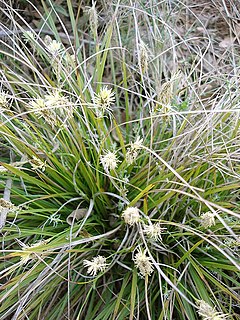
Carex is a vast genus of more than 2,000 species of grass-like plants in the family Cyperaceae, commonly known as sedges. Other members of the family Cyperaceae are also called sedges, however those of genus Carex may be called true sedges, and it is the most species-rich genus in the family. The study of Carex is known as caricology.
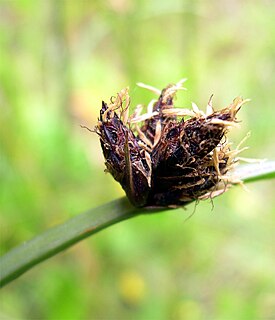
Schoenoplectus pungens is a species of flowering plant in the sedge family known as common threesquare, common three-square bulrush and sharp club-rush. It is a herbaceous emergent plant that is widespread across much of North and South America as well as Europe, New Zealand and Australia.

In botany, a perigynium, also referred to as a utricle, typically refers to a sac that surrounds the achene of plants in the genus Carex (Cyperaceae). The perigynium is a modified prophyll, tissue of leaf origin, that encloses the dry, one-seeded achene.

Carex binervis, the green-ribbed sedge, is a European species of sedge with an Atlantic distribution. It is found from Fennoscandia to the Iberian Peninsula, and occurs in heaths, moorland and other damp, acidic environments. It typically grows to a height of 15–120 cm (6–50 in), and has inflorescences comprising one male and several female spikes, each up to 45 mm (1.8 in) long. The utricles have two conspicuous green veins, which give rise to both the scientific name and the common name of the species. In the vegetative state, it closely resembles C. bigelowii, a species that usually grows at higher altitude. C. binervis was first described by James Edward Smith in 1800, and is classified in Carex sect. Spirostachyae; several hybrids with other Carex species are known.

Carex bigelowii is a species of sedge known by the common names Bigelow's sedge, Gwanmo sedge, and stiff sedge. It has an Arctic–alpine distribution in Eurasia and North America, and grows up to 50 centimetres (20 in) tall in a variety of habitats.

Carex sect. Ovales is a section of the genus Carex, containing around 85 species of sedge. It is the most diverse section of the genus in North America, containing 72 species:

Carex paniculata, the greater tussock-sedge, is a species of flowering plant in the sedge family, Cyperaceae. It grows 1.5 metres high and can be found in most of Europe, Northwest Asia and North America.

Carex distans, commonly known as distant sedge, is a plant species in the sedge family, Cyperaceae. It is native to Europe and North Africa. It is part of a complex of similar species that occur across Eurasia. Its relatives include Carex diluta of central Asia, which has also introduced to North America in Montana. Carex distans has been introduced to the US states including Maryland and Pennsylvania. More recently, it was found in Oregon. There is a report from Victoria, Australia as well.

Carex brunnescens, the brownish sedge or green bog sedge, is a species of plant in the sedge family (Cyperaceae). It has a circumboreal distribution, and is native to North America and Eurasia. In the United States it is primarily found in the Northeast and Midwest extending south into the Appalachian Mountains, with disjunct populations westward in the Rocky Mountains. It has a wide-ranging natural habitat, is in found in forests, bogs, fens, and rock outcrops.
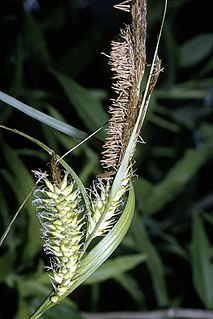
Carex lacustris, known as lake sedge, is a tufted grass-like perennial of the sedge family (Cyperaceae), native to southern Canada and the northern United States. C. lacustris us an herbaceous surface-piercing plant that grows in water up to 50 cm (1.6 ft) deep, and grows 50–150 cm (1.6–4.9 ft) tall. It grows well in marshes and swampy woods of the boreal forest, along river and lake shores, in ditches, marshes, swamps, and other wetland habitat. It grows on muck, sedge peat, wet sand or silt, in filtered or full sunlight.
Carex lemmonii, or Lemmon's sedge, is a plant in the sedge family, and is endemic to California. Carex albida is now considered a synonym, but was previously thought to be a separate species; such plants have the common name white sedge.
Carex acaulis, known as the small dusky sedge, is a species of sedge in the genus Carex native to the Falkland Islands and southern Argentina.

Carex subg. Vignea is a subgenus of the sedge genus Carex, containing around 300 of the 2000 species in the genus. Its members are characterised by having bisexual, sessile spikes, where the female flowers have two stigmas each.

Carex rosea, the rosy sedge, is a flowering plant and part of the family Cyperaceae. Synonyms for Carex rosea include Carex concoluta, and Carex flaccidula. It is native to central and eastern North America and it exists in wet to dry soils. Carex rosea can be found in shores of streams and bottomlands, as well as ponds. It is known to have great adaptations to dry-shade locations. This is an evergreen, easy-to-grow-plant.
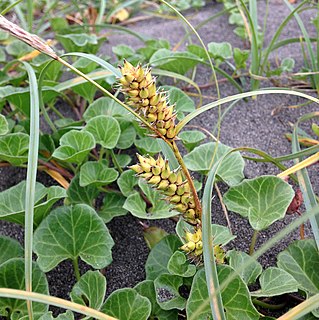
Carex pumila, commonly known as strand sedge or spreading sedge, is a species of sedge of the family Cyperaceae.

Carex viridula, known as little green sedge, green sedge, or greenish sedge, is a small flowering plant native to North America, Europe, Asia, and Morocco.
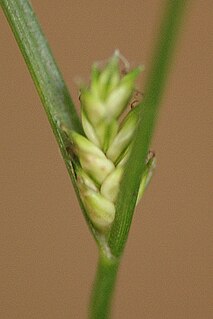
Carex remota, the remote sedge, is a species in the genus Carex, native to Europe, the Atlas Mountains in Africa, and western Asia. It is a riparian forest specialist. It is known as one of the most frequently hybridizing species of Carex, forming hybrids with C. appropinquata, C. arenaria, C. brizoides, C. canescens, C. divulsa, C. echinata, C. elongata, C. leporina, C. otrubae, C. paniculata, and C. spicata.
Carex missouriensis is a species of sedge in the family Cyperaceae, native to the US states of Nebraska, Kansas, Iowa, Missouri, Illinois, and Indiana. It is typically found in swales in surviving patches of prairie.
Carex aequialta is a tussock-forming perennial in the family Cyperaceae, that is native to north eastern parts of Asia.















